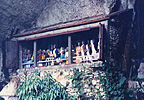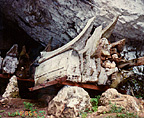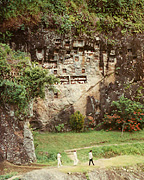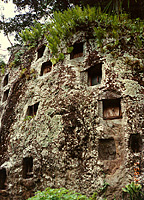| 
|
|
- Ujung Pandang
- The provincial capital of Ujung Pandang has in its
history played an important role as the gateway to the former
kingdom of Gowa and now to the whole province because of its natural
harbour.
The centre of business and administration, the city has expanded
outwards from its most important landmark, that of Benteng Ujung
Pandang which faces the sea front. One of the eleven fortresses
of the kingdom, it was built in 1545 during the reign of Tuni
Pallanga, the 1 0th sultan of Gowa. When Gowa capitulated to the
colonial forces under the treaty of Bungaya in 1667, the fort
was renamed Rotter dam by Admiral Speelman who constructed bastions
and buildings of typical Dutch architecture making it the centre
of the civilian government, including a church on its premises.
One of the best preserved forts of that area, only the thick walls
of earth and stones remain of the original complex, now occupied
by educational and cultural offices of the provincial government.
The two buildings house the Ujung Pandang State Museum, exhibiting
archaeological and historical objects, manuscripts, numismatics,
ceramics and ethnic costumes and ornaments.
Visiting hours of the museum are from 8.00 a.m. until 4.00 p.m.
daily except on Mondays and public holidays. The fort itself is
open daily till 17.00 p.m. Dedicated as a centre of culture, the
Conservatory of Dance and Music is located here and on the open
stage in the centre of the fort, dance classes for children can
be seen in progress.
Though unmarked, but of historical interest is the dungeon where
one of Indonesia's most prominent heroes in the struggle for freedom,
Prince Diponegoro was imprisoned for 27 years. Prince Diponegoro
was buried in a family plot in the middle of the city on a street
named after him: Jalan Diponegoro. The family tree displayed on
the wall indicated that none of his descendants returned to the
courts of Yogyakarta, instead they settled in Ujung Pandang and
their custodian is a greatgrandson.
Mr. Bundt, a Dutchman, has in his private residence at
No. 15 Jalan Mochtar Lutfi a collection of seashells and corals.
His pacious garden is filled with rare Indonesian orchids and
hybrids. A visit is worthwhile and several of the collections
are on sale. Mr. Bundt is registered in the Sanders List of London
as an expert in orchid cultivation.
Sunsets in the Makassar Strait can be viewed from a promenade
at Jalan Penghibur or the Paotere anchorage in the north end of
the city where the Pinisi schooners are berthed.
Across the harbour is Kayangan Island which can be reached in
15 minutes by ferry. A popular recreational resort for the people
of the city, there is entertainment in the evening and on Sundays.
-
- Pare-pare
- Pare-pare is a lunch stop along the road from Ujung
Pandang to Toraja, through paddyfields and typical Bugis houses
made of wood and bamboo, built on stilts. Here we can find the
museum Labangenge, located at Jalan Bau Massepe No. 8 2 Pare-pare.
- Tana Toraja
- Tana Toraja, (Toraja Land) which lies in the north
of the province is known for its unique culture and ancient traditions.
The centre of tourism is Rantepao 328 kms from Ujung Pandang by
road. There are several small bungalow hotels at Rantepao, and
Makale, the district capital. The entry to Tana Toraja is marked
by a gate built in traditional boat-shaped architecture. The road
passes through the mountains of Kandora and Gandang on which,
according to Toraja mythology, the first ancestors of celestial
beings descended from heaven.
The majority of the people still follows an ancestral cult called
"Aluk Todolo" which governs all traditional ceremonies.
From Rantepao, side trips can be made to Kete, a traditional village
where there are handicraft and unique shops. Behind the village
there is a grave site on a hillside. Lifesize statues guard over
old coffins.
As roads are not always paved, it is necessary to use a jeep or
walk if the weather is good {between May and October). Two cliff
graves easy to each are Lemo and Londa. Londa is one of the oldest
hanging graves belonging to the nobility. A large balcony is filled
with effigies of the dead. Kerosene lamps with young village guides,
can be hired to enter the caves to see skeletons and old coffins.
At Lemo, burial chambers are cut out of the rock and several balconies
filled with effigies look out while new caves are being dug to
serve as family graves.
There are several grave sites and traditional villages of which
Palawa is a classic example of a village on a small hill with
"Tongkonan" or a burial place with celebrations and
festivals. Visitors are welcome but they are expected to adhere
to local customs of dress, seating and bringing a token
present.
- Paotere Anchorage
- On the outskirts of Ujung Pandang, Paotere is where
sailing boats and other small vessels anchor to unload their cargo.
The setting casts a glow over the sea with the silhouettes of
the boats and this scenery is most often photographed.
-
- Samalona Island
- Across the harbour of Ujung Pandang is Samalona Island
which has been developed into a pleasant recreational resort.
It can be reached by boat in 45 minutes and has simple accommodation
Recreational sports include diving, snorkeling, water skiing and
fishing. Best months to visit are from February to October.
-
- Sungguminasa
- Formerly the seat of the kings of Gowa, about 11 kms
from Ujung Pandang is the old palace of wood, standing on stilts
facing the town square across the administration office. Now the
Ballalompoa Museum, weapons and costumes of royalty are on display
in glass cases.
The royal regalia which includes a stone studded gold crown weighing
1769 grams can be seen only on special request.
-
- Tomb of Sultan Hasanuddin
- Sultan Hasanuddin (1629-1690) was famous for his exceptional
bravery in his struggle against colonial encroachment in South
Sulawesi. His tomb and those of other kings of Gowa are located
in a secluded cemetery not far from Sungguminasa, about 8 kms
from Ujung Pandang.
The huge crypts are grey with age and just outside the walls of
the cemetery, a small fenced-off plot contains the Tomanurung
stone on which the kings of Gowa were crowned in a show of pomp
and splendour, Not far from the tombs is the oldest mosque in
the area, built in 1603.
-
- Malino
- Formerly the holiday resort of the kings. Malino,
which is 70 kms from Ujung Pandang offers a haven from city-life.
Located on the slopes of Mt. Bawakaraeng it has a cool climate
with forests of pine trees making it picturesque. Deer hunting
on horseback was a royal sport in the days gone by.
-
- Bulukumba
- You will find white sandy beaches at Bira, 178 kms
from Ujung Pandang to the south. Traditional ship building is
also located in this area. Not far from this area visitors can
cross to the island of Selayar.
-
- Goa Mampu
- The largest cave in South Sulawesi, the legendary
cave of Mampu is about 140 kms from the capital. Besides stalagmites
and stalactites, rock formations resemble human figures and animals
to which legends are attached.
The cave is inhabited by bats who shriek and fluter around when
bright lights pierce the darkness.
-
- Bantimurung
- To the north of Ujung Pandang and driving east along
the mountain range, is the Bantimurung waterfalls, about 41 kms
from the capital. A cascade of sparkling water gushes out between
rocky cliffs into a stream shaded by tall trees. Here the air
is filled with butterflies which fly from shrub to shrub over
the water.
These rare brightly coloured ornithoid butterflies are considered
the most beautiful in the world.
-
- Leang-Leang
- Now declared an archaeological site, these prehistoric
caves have strange rock carvings of hands and a wild pig, believed
to be 5,000 year old. The road leads from Maros through the cave-riddled
limestone hills to the site about half an hour's drive from the
airport.
-
- Sengkang
- The capital town of Wajo Regency is well-known for
its silk weaving and is the Centre of Buginese silk. This area
is populated by the Buginese ethnic group, famous for their crossing
to other islands as traders of silk, sarongs and other material.
Here we can find lake Tempe, one of the tourist resorts. Sailing
and boating can be enjoyed on this lake.
-
- Soppeng
- Centre of the silk industry, a spinning mill produces
thread from silk worms. Weaving can be seen in many private homes
along this route which is 240 kms to the northeast of Ujung Pandang.
The finest silk is handloomed by village women who individually
need a whole month to produce two metres of silk. Visitors are
welcome to stop and watch, or make a purchase if there is any
readily available.
In a small Village, Batu-Batu Visitor will find a collection of
royal regalia, consisting of many kind of kris keeping a Buginese
traditional house called Sao Mario.
-
- Enrekang
- 236 kms to the north of Ujung Pandang, you can see
beautiful landscapes at Bambapuang, located 20 kms from Enrekang
to the north on the way to Tanah Toraja. Here can be seen an erotic
mountain called: Batu Kabobong, by its shaped formed by the valley
and slopes. A rest house is built on an elevation, giving a clear
view of the countryside.
-
- Polewali - Mamasa (Polmas)
- Polewali is the capital town of Polmas Regency located
246 kms north of Ujung Pandang. It is inhabited by Mandarnese,
Buginese, Torajans and Javanese ethnic groups. This town is well-known
for its silk sarongs which is called "Sarung Mandar"
and rattan furniture and crafts. There are several small islands
to be reached by fishing boats in 10-16 minutes. All these island,
have white sandy beaches.
|
|
|
 |
















